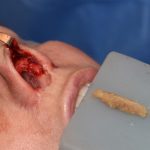
While there are numerous methods available for dorsal augmentation, the use of a graft material is needed for all of them. Cartilage is the best nasal graft material. While it takes greater effort to harvest and shape the dorsal graft using cartilage, the long-term benefits of doing so are always worth it. At the least, there is no risk of foreign body reaction and very little absorption of the graft. Because of the size and length of the nasal dorsum, rib cartilage can always supply an adequate graft amount. (this doesn’t mean that rib is the only donor site)

Besides being easy to make out of cartilage scraps or imperfect graft pieces, a diced cartilage graft can be molded like clay. Once placed on the dorsum, it can be shaped and held in place for one week after surgery with an external splint. The graft is still slightly malleable in the first couple of weeks after surgery. Therefore, if some irregularities are seen early in the first few weeks after surgery, the dorsal graft can be pressed and molded to improve its shape.
Diced cartilage grafts have been shown to be heal together into a solid piece of cartilage without loss of volume. It is able to be revised, reshaped, and easily identified during further surgeries if necessary. In my Indianapolis plastic surgery practice, I have used this technique for over five years and find that the results are similar to pioneers of this technique sat that it is. It has been a revolutionary approach for me in dorsal augmentation, which can be a difficult rhinoplasty manuever because of graft requirements.
Dr. Barry Eppley
Indianapolis, Indiana


